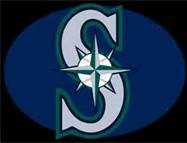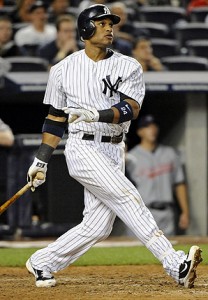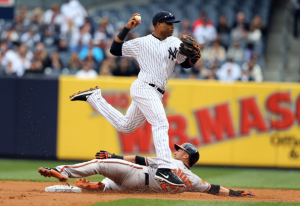 Note: During the off season the Seattle Mariners set Major League baseball on its ear when they signed free agent and former New York Yankees All Star second baseman Robinson Cano to a 10 year $240 million contract. For the Mariners it is the most significant free agent signing in their history and one in which team management broke from their fiscally conservative pattern of recent years when it comes to investing in free agent players. Across his 9 seasons with the Yankees Cano established himself as one of the best hitters in Major League baseball. He is a 5 time All Star and in addition to his hitting prowess has 2 Gold Glove awards (2010 and 2012) to his credit as the best second baseman in the American League. With the 2014 Major League baseball season about to get underway it is time we took a look at our newest Seattle Mariner. Just what is it that makes Robinson Cano so good?
Note: During the off season the Seattle Mariners set Major League baseball on its ear when they signed free agent and former New York Yankees All Star second baseman Robinson Cano to a 10 year $240 million contract. For the Mariners it is the most significant free agent signing in their history and one in which team management broke from their fiscally conservative pattern of recent years when it comes to investing in free agent players. Across his 9 seasons with the Yankees Cano established himself as one of the best hitters in Major League baseball. He is a 5 time All Star and in addition to his hitting prowess has 2 Gold Glove awards (2010 and 2012) to his credit as the best second baseman in the American League. With the 2014 Major League baseball season about to get underway it is time we took a look at our newest Seattle Mariner. Just what is it that makes Robinson Cano so good?

In a recent Seattle Mariners Cactus League game against the Chicago White Sox Robinson Cano stepped to the plate to hit in the bottom of the 7th inning. Seattle was trailing in the game by a score of 7-3, but their first three hitters of the inning had all reached base by way of a single and two walks. Wasting no time Cano took one pitch for a ball and then on the next ripped a drive into the gap between center and left for a bases clearing double. With one swing of his bat the Mariners were back in the game. At the same time M’s fans present got to witness a small sample of what Cano will bring to Seattle’s offense when the team starts the 2014 season next week in Anaheim. The Mariners will be a better team this season, if for no other reason than because they will have Cano playing second base and getting 4 to 5 ‘at bats’ every day—the guy is that good. Seattle hasn’t had an everyday player like this in the lineup since Bret Boone tore up the league back in the Mariners’ legendary, 116 win 2001 season. [1]
A look at Cano’s stats across his 9 year career with the New York Yankees tells the tale of his greatness. His career batting average through that time is .309, his career on base percentage (OBP) is .355, and he averaged 97 runs batted in (RBI) per season while blasting 24 home runs per season.[2] His 9 year average OPS (On Base Plus Slugging Percentage) is .860. Last season he hit .314, drove in 107 runs, hit 27 HRs, had an OBP of .383 and an OPS of .899. Compare those stats to anyone on the Mariners last year and you see why the M’s will be better. The top Seattle hitter average wise last year was Kendrys Morales at .277 and their top OBP man among the regulars was Kyle Seager at .338. Neither was even close to Cano’s career average on either stat, let alone his last year’s stats. The M’s top OPS hitter last season was Raul Ibanez at .793, nearly 100 points less than Cano’s .899 and also far less than his career .860 average. Same story with RBIs—the M’s best was Morales with 80 while Cano averages 97 for EACH SEASON OF HIS CAREER. Last season he had 107. Among all American League hitters last season he was 5th in batting average, 7th in OBP, 7th in slugging percentage and 6th in OPS. He was also 4th in hits, 6th in total bases, 5th in doubles and 4th in RBIs.

On top of this the guy never gets injured. Through the last 7 seasons he has played in an average of 160 games a season. Statistically he is the best pure hitter the M’s have had since Edgar Martinez was in his prime; and when you throw in the fact that he plays a Gold Glove caliber second base—do you now see why Robinson Cano is so good?
I sure do! He will make the whole Mariners team better and it will be a pleasure to watch him this summer at Safeco Field.
Now—let’s play ball!
Copyright © 2014
By Mark Arnold
All Rights Reserved
[1] In 2001 the Seattle Mariners won more games than any team in Major League history since the 1906 Chicago Cubs. A huge reason for this was the year M’s 2nd baseman Bret Boone had. That season Boone had the best campaign of his career, hitting .337 with 37 Home Runs and 141 runs driven in.
[2] Statistical measurements of a baseball player’s production have changed dramatically over the last 15 years or so. Batting average and RBIs (runs batted in) have been traditional hitting stats in baseball. To these have been added an array of other measures for gauging hitting effectiveness. The key ones I use in this article are defined as follows: OBP = On Base Pertcentage, which is determined by the number of times a hitter reaches base by any means, including hits, walks, being hit by a pitch etc divided by his number of plate appearances (‘at bats’); Slugging percentage is the number of total bases a player accrues through his times ‘at bat’ based on a single being 1 base, a double 2 bases, a triple 3 and so on, divided by his number of ‘at bats’. A player who goes 3 for 4 with 2 singles and a double would have a slugging percentage of 1.000 for that game (4 total bases divided by 4 ‘at bats’ ); OPS is simply “on base plus slugging percentage” and is derived by simply adding together a player’s “on base percentage” and his “slugging percentage”. Many baseball statisticians feel that these stats measure a hitter’s productivity in terms helping a team score runs better than the traditional stat of “batting average”.


2 Responses
Well communicated Mark! he’s in elite company next to Edger and he’s a joy to watch!
Play ball!!
Thanks Steve! He has had a great spring thus far and I am fully expecting that he continue on into the regular season. I am intrigued to see how the M’s do this year…more to come on this soon. MA